By Jeffrey M. Miller SPS, DTI
Let me ask you a question: If the odds are already against you in a self-defense attack, on the street, in your home, or wherever a determined attacker who’s targeted you decides it’ll happen – why would you aggravate things more by increasing your disadvantage? I mean, you’d have to be nuts to do something to hurt yourself, and help your attacker in the process – to do anything that would make you, as one of my teachers used to call it…
“an accomplice to YOUR OWN butt-kicking,” right?
This article is about avoiding doing just that. In it, I share with you the number one reason why I avoid teaching my students to use a standard clenched fist when striking your assailant’s face in a self-defense street attack – at least in the way that most people use it. And, I’m going to give you 4 strikes that are much better for getting the results you want, without the same risk in the process!
But first, let me share with you the number one reason that you’d have to be crazy to punch someone in the face with a clenched fist. HINT: It’s the same lesson that even professional fighters who use it on the street… learn too late why it’s, more often than not, a really bad idea!
Ready?
Because you’ll probably damage your own hand in the process.
Don’t believe me? How can this be so? After all, isn’t that what everyone does?
For the most part, the answer is “Yes.” But, at what price?
Look at the boxers and other fighters who get into fights outside of the ring. Do you know what happens, even if they win that street or bar fight? What happens is that most of them…
End up with a broken hand, fingers, or wrist in the process.
And the reason this happens is because it’s almost impossible to punch a human being in the face without making impact with the chisel-like “processes” or ridges on the front part of the skull which make up the face and jaw. In fact, it’s impossible to punch someone in the face with a standard clenched fist – from the eye brow ridge down to the jaw bone (chin), and from the edge of the eyes across the face to the opposite side – without making contact with one of these chisel-like ridges that lay just beneath the skin and small facial muscles.
Not very smart.
Look… with rare exception, the fighters that everyone tries to emulate regardless as to whether we’re talking about boxers, MMA fighters, or Tae Kwon Do practitioners at a martial arts tournament or competition… the one thing that all of these fighters have in common is… GLOVES, which protect the hand against damage and something you won’t have on during a self-defense attack-survival situation!
In fact, there’s another reason which is part of surviving a self-defense situation – one that often happens AFTER the actual attack – a part of the self-defense situation that almost no one ever thinks about until it hits them – until it’s too late. We’ll talk about that in another article, but if you want a quick heads up about it, I made a short video clip that I put up on Youtube that explains this subject and this critical piece of the self-protection “puzzle,” as well as giving you a bonus fist for street survival success. Again, this is only important if real-world self-defense is something you’re serious about getting a handle on: https://www.youtube.com/shorts/GmCCKdc2xBQ
So, now what?
The “now what” is…
What if I could show you how to hit an assailant in the face or head – to get the same kind of bone-jarring, mind-numbing effect that only a head-shot gives you (more in fact) – without risking the breaking of your hand, fingers, or wrist in the process?
Would you be interested?
Somehow, I knew you would.
So, instead of trying to figure out how to hit someone with the same “caveman-style” punch that everyone else is using – regardless of the consequences – let’s look at 4 alternate “fists” that will do more with less energy…
AND… that will not trade off a broken hand (or the problem I highlight in the video I mentioned) for whatever damage you do manage to get in the process.
4 “Fists” That Are Better for Self-Defense
Here are four of the “fists” I teach my students that pack the same, if not more, power in every strike than the more commonly used and conventional, “balled,” fist.
During the course of their training, students learn how to, not just make and strike with each fist but, match them up with the best body targets for maximum effect and minimum effort. Because the goal, unlike a competitive sport fight with multiple rounds, is to end an attack scenario as quickly, effectively, and efficiently as possible!
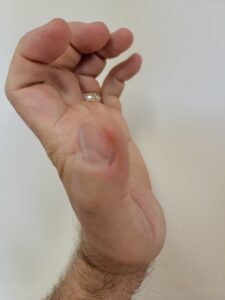
1) Palm-heel strike – By using the base of the palm – the solid part of the palm, closest to the wrist and in alignment with the ends of the forearm bones, you get the battering-ram like power without the need to worry about your wrist folding, or breaking the smaller bones of your fingers when they collide with the facial bones. In fact, like most of the fists that I’m sharing with you today, it actually fits right in-between those chisel-like, bony problem areas on the skull that I am constantly warning my students about!
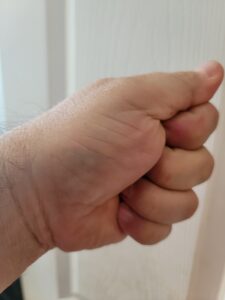 2) Thumb-drive strike – The tip of the thumb can deliver amazing power and damage to the thinner bones in front of the sinus cavities, as well as everywhere else on the face and body that’s weak or that has a thinner layer of muscle over bone. By making a standard fist, and then pressing the middle joint of the thumb down on top of the folded index finger, you now have the capability of taking the power generated by the mass of the larger clenched fist, and concentrating it onto a much smaller point.
2) Thumb-drive strike – The tip of the thumb can deliver amazing power and damage to the thinner bones in front of the sinus cavities, as well as everywhere else on the face and body that’s weak or that has a thinner layer of muscle over bone. By making a standard fist, and then pressing the middle joint of the thumb down on top of the folded index finger, you now have the capability of taking the power generated by the mass of the larger clenched fist, and concentrating it onto a much smaller point.
Think: turning the flat surface of a sledge hammer into the concentrated point of a pick-axe!
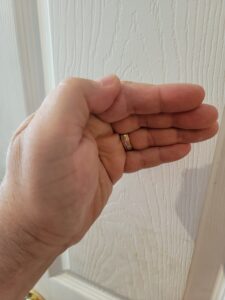 3) Knife-hand strike – Also know conventionally as the “karate chop” or “judo-chop,” the knife-hand strike concentrates the striking force along the outer-edge of the palm, along the side of the hand. Again, just like the palm-heel strike, the narrow nature of this “fist” allows it to slip easily between the dnagerous protrusions at the front of the skull and into the weaker bone surfaces behind the face that everyone else focuses on while minimizing damage to your own body part.
3) Knife-hand strike – Also know conventionally as the “karate chop” or “judo-chop,” the knife-hand strike concentrates the striking force along the outer-edge of the palm, along the side of the hand. Again, just like the palm-heel strike, the narrow nature of this “fist” allows it to slip easily between the dnagerous protrusions at the front of the skull and into the weaker bone surfaces behind the face that everyone else focuses on while minimizing damage to your own body part.
This fist is also perfect for the side of the head, neck, and other similar weak points on your assailant’s body to end his brutal attempts at harming you!
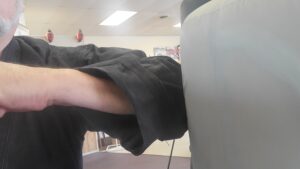 4) Forearm strike – What most people think of as a tool merely for blocking, the real self-defense expert sees as a clubbing weapon. The forearm – especially the ulnar bone (the bone on the outside edge of the forearm in line with the “pinky” finger) – can cause even the most determined attacker to drop in his tracks.
4) Forearm strike – What most people think of as a tool merely for blocking, the real self-defense expert sees as a clubbing weapon. The forearm – especially the ulnar bone (the bone on the outside edge of the forearm in line with the “pinky” finger) – can cause even the most determined attacker to drop in his tracks.
Each of these strikes is unconventional to say the least. But, that’s the point of training, isn’t it – to develop stronger, more accurate, and better techniques, tactics, and strategies that will allow you to survive an attack from a bigger, faster, and/or stronger assailant who’s looking to beat, break or kill you or someone you love – to be the “winner” at the end of it all?
Of course it is.
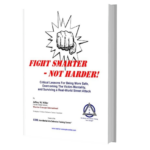
Just remember that fighting, even self-defense, holds the risk that you could be severely injured in the process. But, your training should help to minimize this damage and the wear-and-tear on you in the process, not cause you to hurt yourself and failing (or worse) because you gave up whatever advantage you may have had by using an inferior skill or technique! And, especially when it comes to defending yourself, the idea is to “fight smarter – not harder!”, the title of one of my free self-defense books designed to give you even more perspectives in this area. If you’re interested in learning more, you can download it HERE.
Effective self defense requires more than just a few “karate moves.” It involves the ability to think strategically, and understand how to defend yourself with as little wear-and-tear on you as possible.
If you really want to know what most people don’t know about how to master self defense and how to survive a real street attack, grab your copy of my self defense book: “Fight Smarter – Not Harder!” It’s available free at: https://onlineninjaacademy.com/fight-smarter-not-harder/
ABOUT THE AUTHOR
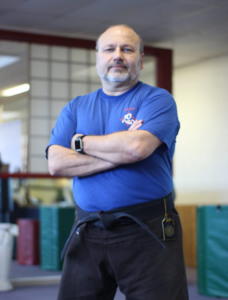
Jeffrey M. Miller is an internationally-known self defense expert. Each month he teaches literally thousands of students; through live seminars, corporate training events, and his online self defense courses; to be able to survive in Today’s often dangerous world. Sensei Miller is the master instructor of Warrior Concepts Black Belt & Life Mastery Academy, as well as a best-selling author, lecturer, and corporate workplace violence consultant who has helped such companies and organizations as Geisinger Medical Center, Girl Scouts of America, Stephen F. Austin University, and Nissan North America to name a few. His study, training, and real-world experience as a soldier, federal police officer, and security specialist who has used what he’s teaching on the streets against actual violent attackers; means that you can trust him to teach you what you need to know to be able to do the same yourself.
Another Question…
Are you a serious man or woman concerned about the danger that exists in today’s world, and worried that it will come at you or someone you love and want to be able to protect? Well, you’re not alone. We specialize in helping modern hero-protectors stop the demons we all know exists in the world from touching the lives of those we have a responsibility to keep safe.
If this describes you, then I invite you to check out our unique, life changing “Protect Yourself and Others” 6-week introductory self-defense program. For more information and to find out when the next session begins, call the Warrior Concepts Academy at (570) 884-1118 or LEARN MORE HERE.
OTHER PROGRAMS & RESOURCES BY WARRIOR CONCEPTS:
Children’s Martial Arts Programs in Selinsgrove Pa – Learn More
Child Safety 24/7 Free Report – Download Here
Martial Arts Classes for Teens and Adults – Learn More
“Strong Kid – Safe Kid” Children’s Martial Arts Intro Program LEARN MORE
3 Ways to Get Started at Warrior Concepts Learn More Here
